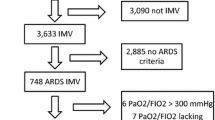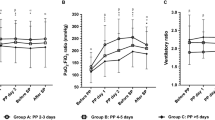Abstract
Purpose
Placing patients with severe acute respiratory distress syndrome (ARDS) in the prone position has been shown to improve survival as compared to the supine position. However, a higher frequency of pressure ulcers has been reported in patients in the prone position. The objective of this study was to verify the impact of prone positioning on pressure ulcers in patients with severe ARDS.
Methods
This was an ancillary study of a prospective multicentre randomised controlled trial in patients with severe ARDS in which the early application of long prone-positioning sessions was compared to supine positioning in terms of mortality. Pressure ulcers were assessed at the time of randomisation, 7 days later and on discharge from the intensive care unit (ICU), using the four-stage Pressure Ulcers Advisory Panel system. The primary end-point was the incidence (with reference to 1,000 days of invasive mechanical ventilation or 1,000 days of ICU stay) of new patients with pressure ulcers at stage 2 or higher from randomisation to ICU discharge.
Results
At randomisation, of the 229 patients allocated to the supine position and the 237 patients allocated to the prone position, the number of patients with pressure ulcers was not significantly different between groups. The incidence of new patients with pressure ulcers from randomisation to ICU discharge was 20.80 and 14.26/1,000 days of invasive mechanical ventilation (P = 0.061) and 13.92 and 7.72/1,000 of ICU days (P = 0.002) in the prone and supine groups, respectively. Position group [odds ratio (OR) 1.5408, P = 0.0653], age >60 years (OR 1.5340, P = 0.0019), female gender (OR 0.5075, P = 0.019), body mass index of >28.4 kg/m2 (OR 1.9804, P = 0.0037), and a Simplified Acute Physiology Score II at inclusion of >46 (OR 1.2765, P = 0.3158) were the covariates independently associated to the acquisition of pressure ulcers.
Conclusion
In patients with severe ARDS, prone positioning was associated with a higher frequency of pressure ulcers than the supine position. Prone positioning improves survival in patients with severe ARDS and, therefore, survivors who received this intervention had a greater likelihood of having pressure ulcers documented as part of their follow-up. There are risk groups for the development of pressure ulcers in severe ARDS, and these patients need surveillance and active prevention.

Similar content being viewed by others
References
Guerin C, Reignier J, Richard JC, Beuret P, Gacouin A, Boulain T, Mercier E, Badet M, Mercat A, Baudin O, Clavel M, Chatellier D, Jaber S, Rosselli S, Mancebo J, Sirodot M, Hilbert G, Bengler C, Richecoeur J, Gainnier M, Bayle F, Bourdin G, Leray V, Girard R, Baboi L, Ayzac L, Group PS (2013) Prone positioning in severe acute respiratory distress syndrome. N Engl J Med 368:2159–2168
Gattinoni L, Tognoni G, Pesenti A, Taccone P, Mascheroni D, Labarta V, Malacrida R, Di Giulio P, Fumagalli R, Pelosi P, Brazzi L, Latini R (2001) Effect of prone positioning on the survival of patients with acute respiratory failure. N Engl J Med 345:568–573
Beuret P, Carton MJ, Nourdine K, Kaaki M, Tramoni G, Ducreux JC (2002) Prone position as prevention of lung injury in comatose patients: a prospective, randomized, controlled study. Intensive Care Med 28:564–569
Curley MA, Hibberd PL, Fineman LD, Wypij D, Shih MC, Thompson JE, Grant MJ, Barr FE, Cvijanovich NZ, Sorce L, Luckett PM, Matthay MA, Arnold JH (2005) Effect of prone positioning on clinical outcomes in children with acute lung injury: a randomized controlled trial. JAMA 294:229–237
Voggenreiter G, Aufmkolk M, Stiletto RJ, Baacke MG, Waydhas C, Ose C, Bock E, Gotzen L, Obertacke U, Nast-Kolb D (2005) Prone positioning improves oxygenation in post-traumatic lung injury–a prospective randomized trial. J Trauma 59:333–341 (discussion 341–333)
Chan MC, Hsu JY, Liu HH, Lee YL, Pong SC, Chang LY, Kuo BI, Wu CL (2007) Effects of prone position on inflammatory markers in patients with ARDS due to community-acquired pneumonia. J Formos Med Assoc 106:708–716
Sud S, Sud M, Friedrich JO, Adhikari NK (2008) Effect of mechanical ventilation in the prone position on clinical outcomes in patients with acute hypoxemic respiratory failure: a systematic review and meta-analysis. CMAJ 178:1153–1161
Allman RM, Goode PS, Burst N, Bartolucci AA, Thomas DR (1999) Pressure ulcers, hospital complications, and disease severity: impact on hospital costs and length of stay. Adv Wound Care 12:22–30
Manzano F, Navarro MJ, Roldan D, Moral MA, Leyva I, Guerrero C, Sanchez MA, Colmenero M, Fernandez-Mondejar E, Granada UPPG (2010) Pressure ulcer incidence and risk factors in ventilated intensive care patients. J Crit Care 25:469–476
Cox J (2011) Predictors of pressure ulcers in adult critical care patients. Am J Crit Care 20:364–375
Kaitani T, Tokunaga K, Matsui N, Sanada H (2010) Risk factors related to the development of pressure ulcers in the critical care setting. J Clin Nurs 19:414–421
Cox J (2013) Pressure ulcer development and vasopressor agents in adult critical care patients: a literature review. Ostomy Wound Manage 59(50–54):56–60
Sayar S, Turgut S, Dogan H, Ekici A, Yurtsever S, Demirkan F, Doruk N, Tasdelen B (2009) Incidence of pressure ulcers in intensive care unit patients at risk according to the Waterlow scale and factors influencing the development of pressure ulcers. J Clin Nurs 18:765–774
Bergquist-Beringer S, Dong L, He J, Dunton N (2013) Pressure ulcers and prevention among acute care hospitals in the United States. Jt Comm J Qual Patient Saf 39:404–414
Shea JD (1975) Pressure sores: classification and management. Clin Orthop Relat Res (122):89–100
Black J, Baharestani MM, Cuddigan J, Dorner B, Edsberg L, Langemo D, Posthauer ME, Ratliff C, Taler G, (NPUAP) aTNPUAP (2007) National pressure ulcer advisory panel’s updated pressure ulcer staging system. Dermatol Nurs 19:343
Le Gall JR, Lemeshow S, Saulnier F (1993) A new simplified acute physiology score (SAPS II) based on a European/North American multicenter study. JAMA 270:2957–2963
Bone RC, Balk RA, Cerra FB, Dellinger RP, Fein AM, Knaus WA, Schein RM, Sibbald WJ (1992) Definitions for sepsis and organ failure and guidelines for the use of innovative therapies in sepsis. The ACCP/SCCM Consensus Conference Committee. American College of Chest Physicians/Society of Critical Care Medicine. Chest 101:1644–1655
Charlson ME, Pompei P, Ales KL, MacKenzie CR (1987) A new method of classifying prognostic comorbidity in longitudinal studies: development and validation. J Chronic Dis 40:373–383
Vincent JL, Moreno R, Takala J, Willatts S, De Mendonca A, Bruining H, Reinhart CK, Suter PM, Thijs LG (1996) The SOFA (sepsis-related organ failure assessment) score to describe organ dysfunction/failure. On behalf of the Working Group on Sepsis-Related Problems of the European Society of Intensive Care Medicine. Intensive Care Med 22:707–710
Guerin C, Gaillard S, Lemasson S, Ayzac L, Girard R, Beuret P, Palmier B, Le QV, Sirodot M, Rosselli S, Cadiergue V, Sainty JM, Barbe P, Combourieu E, Debatty D, Rouffineau J, Ezingeard E, Millet O, Guelon D, Rodriguez L, Martin O, Renault A, Sibille JP, Kaidomar M (2004) Effects of systematic prone positioning in hypoxemic acute respiratory failure: a randomized controlled trial. JAMA 292:2379–2387
McInnes E, Jammali-Blasi A, Bell-Syer SE, Dumville JC, Cullum N (2011) Support surfaces for pressure ulcer prevention. Cochrane Database Syst Rev (4):CD001735
Conflicts of interest
The authors declare no conflict of interest.
Author information
Authors and Affiliations
Consortia
Corresponding author
Additional information
Take-home message: In patients with severe ARDS, prone positioning was associated with a higher risk of pressure ulcers than the supine position. This means preventive measures should be implemented when the decision to use prone positioning is made.
Electronic supplementary material
Below is the link to the electronic supplementary material.
Rights and permissions
About this article
Cite this article
Girard, R., Baboi, L., Ayzac, L. et al. The impact of patient positioning on pressure ulcers in patients with severe ARDS: results from a multicentre randomised controlled trial on prone positioning. Intensive Care Med 40, 397–403 (2014). https://doi.org/10.1007/s00134-013-3188-1
Received:
Accepted:
Published:
Issue Date:
DOI: https://doi.org/10.1007/s00134-013-3188-1




